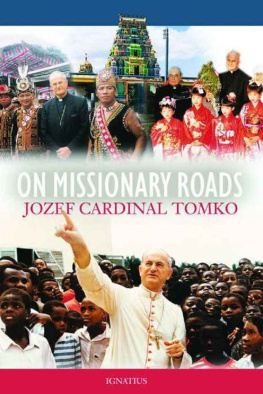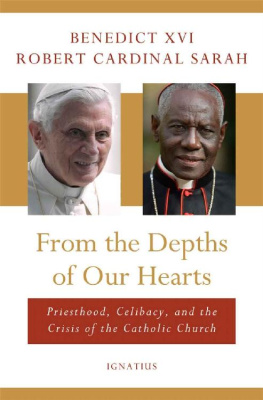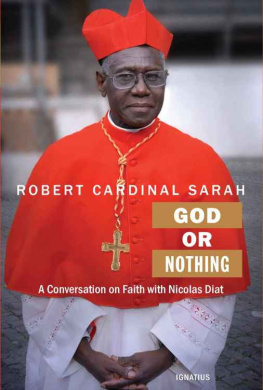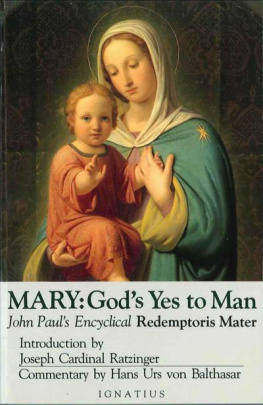ON MISSIONARY ROADS
JOZEF CARDINAL TOMKO
ON MISSIONARY ROADS
Translated by
Reverend Lubomir J. Streok
Sister Mercedes Voytko, SSCM
Sister Anna Catherine Melichar, OSF
IGNATIUS PRESS SAN FRANCISCO
Originally published in 2003 as Na misijnch cestch II
by Spolok Svtho Vojtecha
Trnava, Slovakia
2003 Spolok Svtho Vojtecha
Cover photographs Jozef Cardinal Tomko
Cover design by John Herreid
2006 by Ignatius Press, San Francisco
All rights reserved
ISBN 978-1-58617-165-0
ISBN 1-58617-165-8
Library of Congress Control Number 2006921887
Printed in Canada
Contents
Republic of Zimbabwe
Republic of Botswana
Kingdom of Lesotho
Kingdom of Swaziland
Republic of Mozambique
Republic of South Africa
Republic of Namibia
Republic of Madagascar
Department of Reunion
Republic of Zambia
Republic of Malawi
Republic of Mauritius and Republic of Seychelles
Republic of Angola
Democratic Republic of the Congo
Republic of the Congo and Republic of Central Africa
Gabonese Republic
Republic of Burundi and Republic of Rwanda
Republic of Cameroon
Federal Republic of Nigeria
Republic of Ghana
Republic of Cte dIvoire (Ivory Coast)
Republic of Benin
Togolese Republic
Republic of Senegal
Republic of Mali
Burkina Faso
Republic of Niger
Republic of Chad
Republic of Guinea-Bissau
Republic of Guinea (Conakry)
Republic of the Gambia
Republic of Liberia and Republic of Sierra Leone
Republic of Cape Verde
United Republic of Tanzania
Republic of Kenya
Republic of Uganda
Federal Democratic
Republic of Ethiopia and State of Eritrea
Somalia and the Republic of Djibouti
Republic of the Sudan Arab
Republic of Egypt
Libya (Great Socialist Peoples Libyan Arab Jamahiriya)
Tunisian Republic, Peoples Democratic Republic of Algeria, and Kingdom of Morocco Additional Territories
Kingdom of Saudi Arabia
United Arab Emirates
Islamic Republic of Pakistan and Peoples Republic of Bangladesh
Malaysia
Republic of Indonesia and Democratic Republic of East Timor
Republic of India
Kingdom of Nepal
Democratic Socialist Republic of Sri Lanka
Kingdom of Thailand
Union of Myanmar (Burma)
Kingdom of Cambodia and Socialist Republic of Vietnam
Peoples Republic of China Taiwan
Republic of Outer Mongolia
Republic of Korea (South Korea)
Japan
Republic of the Philippines
Republic of Kazakhstan Siberia
United Mexican States
Central America
Antilles Islands
Republic of Colombia
Republic of Peru
Republic of Ecuador
Federative Republic of Brazil
Argentine Republic
Kingdom of Tonga
Papua New Guinea
Republic of the Fiji Islands
Republic of Albania
Bosnia and Herzegovina
Gibraltar

On One of Many Journeys with John Paul II
Foreword
The Church on earth is, by her very nature, missionary ( Ad gentes , no. 2). This was the striking declaration of the Second Vatican Council in its Decree on the Churchs Missionary Activity . The decree set out in one document the foundations of the missionary theology and practice of the Catholic Churcha magna carta of mission.
Since 1622, the Churchs missionary work had been organized and coordinated at the world level by the Congregation for the Propagation of the Faith in collaboration with many religious orders and congregations and with the local Churches. At the Vatican Council, the role of the Congregation was affirmed, and it was renamed the Congregation for the Evangelization of Peoples. At the same time, a strong desire was expressed for its greater effectiveness. It was acknowledged that the Holy Spirit arouses a missionary spirit in the Church in many ways and indeed often anticipates the work of those whose task is to guide the life of the Church ( Ad gentes, no . 29). In a changing world, it would be important that the Congregation should be, in its members and staff, more effectively representative of the whole Church. The Council confirmed its role as the only competent Congregation for all mission and missionary activity. Its task is to direct and coordinate missionary work and missionary cooperation throughout the world (ibid.).
The years that followed the Vatican Council have been a challenging time for the Congregation. The renewal proposed by the Council became more urgent as massive social and cultural changes took place with the stirring of globalization. This has affected the whole Church, not least in her mission. The debate within the Church about the nature and means of mission, though given direction by the Council decree on mission, took many turns, not all of them positive. The Holy See, under the leadership of Pope Paul VI, Pope John Paul II, and the Congregation for the Evangelization of Peoples, led from 1985 to 2001 by Cardinal Josef Tomko, have done a major work of developing the Magisterium of missionary theology for which the Council decree had laid the foundation.
The task of the Congregation is also highly practical. In new times and situations, communication between its office in Rome and the local Churches, the mission-sending religious communities, and the worldwide network of mission support organizations has taken on a new urgency.
In his years as Prefect of the Congregation for the Evangelization of Peoples, Cardinal Josef Tomko addressed himself to this task. Fully in the spirit of Pope John Paul II, he was himself present to the missionary work of the Church in all parts of the world. His concern for seminary reform, for the nomination of courageous and faithful bishops, for the development of consecrated life, and for social justice has strengthened the life of those local Churches supervised by the Congregation for Evangelization.
In his book, Cardinal Tomko describes his firsthand experience of missionary work as it takes place today all over the world. We see his reflective and sympathetic leadership in action and are given a firsthand glimpse of the Congregation for Evangelization, renewed by Vatican II and its successive prefects.
Cardinal Tomko has given us a gift in this book that can help us appreciate the Churchs response today to the mission given her by Christ two thousand years ago. He deserves our gratitude too for what he has done for the missionary well-being of the Church over the years that he was Prefect of the Congregation for the Evangelization of Peoples. The book is an invitation to share in his generous missionary spirit and, like him, to do great things for the Lord.
+ Francis Cardinal George, OMI
Archbishop of Chicago
Introduction
This book can be considered an invitation to become better acquainted with a world about which we speak little at all, or only under the aspect of economic globalization. It is the world of ancient religions and of young churches, which Christians call mission territories or simply the missions in its classical sense. In the Catholic Church, there has existed since 1622 a central office that has continued to coordinate missionary work and missionary cooperation throughout the world. This office is called the Congregation for the Evangelization of Peoples (formerly the Propaganda Fide ), and it is a privileged observation post allowing one to acquire a unique and broad experience of this vast field of activity.
When the unforgettable Pope John Paul II called me to guide this Congregation in April 1985, I immediately understood it was not enough to consider the enormous questions and problems of competency and responsibility from behind a desk and only through the large number of reports and communications received every day. I saw the necessity of having direct contact with the people and the workers in the vineyard.
Next page








